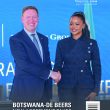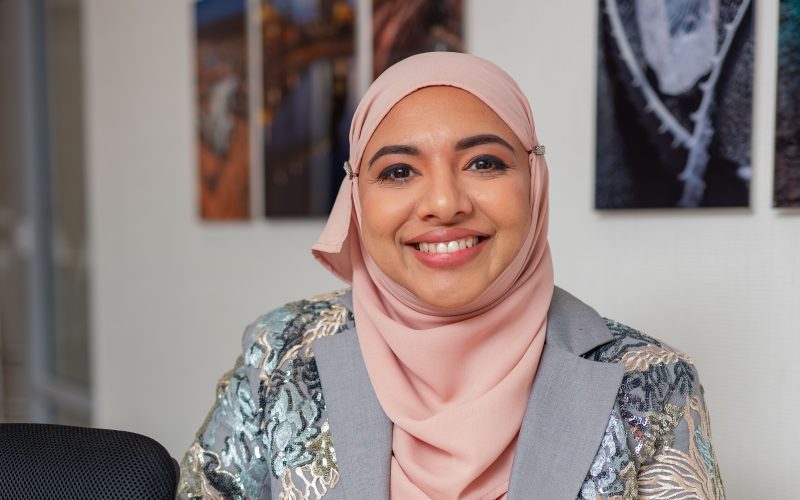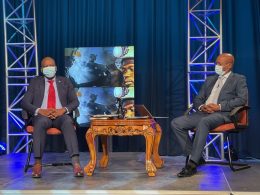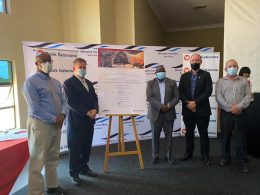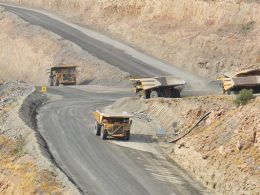Lucara Botswana, a diamond mining company that operates Karowe Mine, is not only known for unearthing the rarest diamonds in the world, but also for its impact on the communities it operates in and beyond.
The company is leading the race when it comes to corporate social investment, going beyond tokenism to create an eternal legacy. Lucara Botswana’s initiatives are underpinned by the United Nations Sustainable Development Goals, a set of 17 goals that aim to achieve a better and more sustainable future for all people and the planet by 2030. They were adopted by the United Nations in 2015 as part of the 2030 Agenda for Sustainable Development, which is a shared blueprint for peace and prosperity.
“Lucara Botswana has adopted 10 out of the 17 United Nations Sustainable Development Goals and these are the drivers of the company’s Corporate Social Responsibility Initiatives. We will continue to contribute to positively impacting the communities around Karowe where we operate and in Botswana as a whole. Our aim as Lucara Botswana is to ensure we provide a platform for communities to create generational wealth.In turn this creates sustainable projects.” said Lucara Botswana Managing Director, Naseem Lahri in an exclusive interview with The Projects Magazine.
“We are currently almost at the tail end of the construction of a Sports Complex in Letlhakane which we believe will bring great revenue to Letlhakane as well as influence a large uptake in sports for the youth in the community.”
Lucara Botswana also established the Karowe Village Initiatives Program which facilitates meaningful and income-generating initiatives that empower communities to create and sustain income-generation projects. Some of these projects include the Mokubilo Integrated Farm (the Green Diamond as it is fondly known), Khwee Small Stock and Fodder Production.
“The highlight of all our KVI initiatives, led to Lucara Botswana receiving a Junior ESG Award in the Economy Category at the Mining Indaba 2022. The award recognised Lucara Botswana’s Mokubilo Farm Project, which employs women and men from the local area, and generates income for the community,” said Lahri.
Lucara Botswana is a subsidiary of Lucara Diamond Corp, a Canadian company primary listed on the TSX, secondary on the Swedish Stock Exchange, and the Botswana Stock Exchange. The company runs Karowe Mine, a state-of-the-art mine located 20km out of Letlhakane Village.
Karowe Mine was fully commissioned in Q2 2012 and is one of the world’s foremost producers of large, high quality, Type IIA diamonds in excess of 10.8 carats, including the historic 1,109 carat Lesedi La Rona, 1,758 Sewelo, and the 813-carat Constellation. These diamonds have fetched record-breaking prices and attracted global attention for their size, quality, and rarity.
ADVANCING SUSTAINABILITY AGENDA
Sustainability is a key concern in the mining sector because mining can have significant impacts on the natural environment and human health, as well as on the social and economic well-being of the communities where it operates. In 2022, Lucara Botswana made significant strides in advancing its sustainability agenda.
“We have embraced the principles of environmental stewardship, social responsibility, and sound governance to guide our actions and decisions. Our commitment to our employees’ well-being has remained steadfast, with the organization achieving zero Lost Time Injury (LTI) and successfully retaining our ISO 45001: 2018 certification.
To support the company’s ESG performance, the Board has established a Governance and Assurance Department to coordinate corporate-wide regulatory compliance in collaboration with substantive departments, and to coordinate Internal Audits for assurance purposes,” said Lahri.
The coordination of regulatory compliance includes the management of all relevant regulatory requirements, including Anti-Money Laundering (AML) and Counter-financial Terrorism (CFT) initiatives, as well as other legal requirements, such as stakeholder Data Protection, and compliance with all relevant environmental requirements.
“In recognition of the role that all departments play in ESG, and to assist in the implementation of the company’s ESG strategy, technical working groups and committees (Climate Change Decarbonisation working group, ESG Committee, Biodiversity Working Group and Community Impact Working Group) have been set up,” she said.
“Furthermore, we are a certified member of the Responsible Jewellery Council, the world’s leading standard-setting organisation for the jewellery and watch industry. We adhere to the Kimberley Process, an international certification scheme that regulates trade in rough diamonds.”
Lahri indicated that Lucara is also a founding member of the Natural Diamond Council, which seeks to advance the integrity of the modern diamond jewellery industry and inspires, educates, and protects consumers. She said the company’s approach to innovation is centred on continuous improvement and technological advancement.
“This includes research and development, and we strive to explore sustainable mining technologies that reduce our environmental impact. Through collaboration, piloting, and scaling up of innovative solutions to our operational challenges, we strive to set new industry benchmarks,” she said.
“Our culture of continuous improvement and risk management also seeks to drive positive social outcomes while minimising our ecological footprint. By embracing innovation in our everyday work, we aim to lead in responsible and sustainable diamond mining practices.”
TECHNOLOGY AND LARGE STONES
Lucara Botswana has gained world fame for its famous stones, but at the core of the success, is investment in cutting-edge mining technology. In 2015, a major plant upgrade project, primarily integrating new large diamond recovery (LDR) X-ray transmissive technology (XRT) machines, was introduced to process harder ore and to improve the recovery of exceptional diamonds.
The most significant results from the optimisation project were the recovery of a 1,109 ct gem quality Type IIA diamond which was later named Lesedi La Rona, and an 813ct stone and a 374ct stone white diamonds in mid-November 2015. Lesedi La Rona, which measured 65mm x 56mm x 40mm in size, was at the time the world’s second biggest gem quality diamond ever to be recovered and the biggest diamond to be recovered through a modern processing facility, as well as the biggest diamond recovered in Botswana at the time.
“Given the significance of technology in the recovery of these large stones, Lucara Botswana further installed the highly successful XRT technology to process finer size fractions at its Karowe Mine. The technology included four new XRT diamond recovery units and the associated conveying and screening infrastructure which targets the recovery of diamonds in the size range of 4 mm to 8 mm,” stated Lahri.
“The XRT technology addressed processing of the very dense high quality south lobe ore at depth and will result in the most efficient and cost effective processing methodology for processing this ore.”
Through this technology, Lucara Botswana has over 90 percent diamond recovery rate and minimal breakages. One of the testimonies of this technology is that in April 2019, the largest diamond to be mined at Karowe to date, an unbroken 1,758 carat near-gem quality diamond, was recovered.
This recovery is the largest diamond recovered in Botswana and one of the largest diamonds recorded in history, superseding the spot held by the 1,109 carat Lesedi La Rona recovered at Karowe in 2015. Meaning “rare find” in Setswana, the name Sewelô was selected for the diamond from over 22,000 submissions in a contest open to all citizens of Botswana. The unbroken stone was recovered through Lucara’s XRT circuit in April 2019.
KAROWE HIGH PROFILE STONES RECOVERED IN THE PAST 10 YEARS
SEWELO
The Sewelô diamond is the third-largest rough diamond ever found. The diamond was recovered in April 2019 by the Lucara Diamond Corp in its Karowe diamond mine in Botswana. The diamond is 1,758 carats and weighs 352 grams or 12.39 oz. The Sewelô is the largest diamond in Botswana’s history, surpassing the 1,111 carats (222 g, 7.83 oz.) Lesedi La Rona extracted at the same mine on 16 November 2015. The Lesedi La Rona was the fourth-largest diamond ever found, and the third-largest of gem quality.
LESEDI LA RONA
Lesedi La Rona, is the fourth-largest diamond ever found, and the third-largest of gem quality. It was found in the Karowe mine, (formerly called AK6) in Botswana on 16 November 2015. British jeweller Graff bought the rough diamond for $53 million in 2017.
CONSTELLATION
“The Constellation” — was found in November 2015 at the Karowe mine, in Botswana and was sold for $63 million, then a new record for a rough gem and luxury good,
THE KAROWE UNDERGROUND PROJECT
The Karowe UGP is designed to access the highest value portion of the Karowe orebody, with initial underground carat production predominantly from the highest value eastern magmatic/pyroclastic kimberlite (“EM/PK(S)”) unit.
The underground expansion is expected to extend mine life to at least 2040 and is forecast to contribute approximately $4 billion in additional revenues using conservative diamond price assumptions which are unescalated and exclude exceptional stone revenue.
On July 16, 2023, an update to the Karowe UGP schedule and budget was announced. This update was initiated in response to slower than planned ramp up to expected sinking rates, and, to account for time incurred to date, as well as for anticipated future grouting programs.
Grouting programs took longer than anticipated due to a combination of high-water volumes in the sandstone lithologies between 870 and 752 metres above sea level in depth (144 metres to 262 metres below the shaft collar) combined with technical challenges associated with the transition to main sinking.
The updated schedule incorporates a 28% increase in the duration of construction, extending the anticipated commencement of production from the underground from H2 2026 to H1 2028. The revised forecast of costs at completion is $683 million (including contingency), a 25% increase to the May 2022 estimated capital cost of $547 million.
The increase of $136.0 million in estimated capital to reach project completion is predominantly related to increased schedule duration and related labour costs (about 56% of the total), grouting costs (approximately 20% of the total capital increase), with the balance of the increase attributable to Owner’s costs, procurement, and indirect project costs. As at June 30, 2023, capital expenditures of $264.5 million had been incurred and total capital commitments of $369.7 million had been made, inclusive of incurred amounts.
The Karowe UGP remains technically and economically feasible, however, the impact of actual and modelled delays changes the revenue profile due to the use of lower-grade, stockpiled ore for mill feed rather than high-grade ore from the underground as previously planned.
Sufficient surface stockpiles of South, Centre and North Lobe kimberlite ore are available to maintain current, un-interrupted mill feed to the plant for the duration of the anticipated delay.
The long-term outlook for diamond prices, combined with the potential for exceptional stone recoveries and the continued strong performance of the open pit could mitigate the modelled impact on project cash flows due to the schedule slippage.



